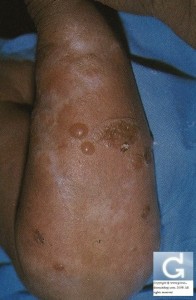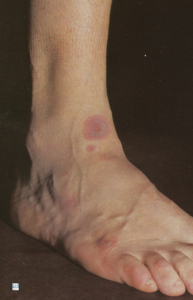Skin diseases in pregnancy
Dr Christophe Hsu – dermatologist. Geneva, Switzerland
What are normal skin changes that occur during pregnancy?
- Due to hormonal changes during pregnancy, the skin around the nipple and genital becomes dark and a dark line develop in the middle of the abdomen (called Linea Nigra).
- There may be purplish to pink streaks of stretch marks as the abdomen enlarges when the baby grows in the womb because of the stretching of the skin. These are called Striae .These are all physiological skin changes that occur during pregnancy.
- Some women also develop pigmentation on the face (melasma).
Are these changes permanent; and can they be treated?
- The physiological skin changes tend to remain for sometime after delivery; but they usually fade, often not completely, with time.
- Pigmentation can be lightened with bleaching cream.
- Stretch marks usually lighten in color but rarely disappear. Creams advertised to prevent stretch marks generally do not work.
- Most skin diseases during pregnancy are harmless to the baby. However, Rubella (German measles), Syphilis and Genital Herpes Simplex Infection can be harmful to the baby in the womb.
a) Rubella (German measles)
- This infection is caused by a virus which is spread by coughing and sneezing.
- Shortly after infection with the rubella virus, a non-itchy rash appears all over the body which lasts for 2-3 days.
- If infection occurs during the first 20 weeks of pregnancy, the baby may develop birth defects or may even die within the uterus.
- All females should be vaccinated against Rubella during childhood; but no females should be vaccinated during pregnancy.
b) Syphilis
- Syphilis is a sexually transmitted disease.
- In the early stage of syphilis, painless ulcers appear in the genitals which heal spontaneously within 3 weeks even without treatment. Rashes appear on the skin, palms, soles and mouth 6-8 weeks later.
- If infection occurs during pregnancy, the baby may be born with heart-, bone- and brain-defects.
- All women are routinely tested in industrialized countries for syphilis during their regular check-up for pregnancy.
c) Genital herpes
- Herpes simplex infection is caused by a virus.
- Infection of the genitals is usually acquired by sexual contact.
- It is often a recurrent disease.
- It presents as painful blisters and sores on the genitals and the virus may be present in the vagina even without symptoms.
- During delivery, the baby may become infected by the virus and cause infection on the skin, in the brain and liver. Infection of the newborn can be prevented by ensuring that the mother’s infection is under controlled during delivery; a Caesarian section may be necessary.
What skin diseases are specifically seen during pregnancy ?
The following skin diseases occur only during pregnancy and they usually clear after delivery:
- A) Polymorphous Eruption of Pregnancy
- One in 300 pregnant women develop this itchy skin disease.
- The rash usually starts on the stretch marks on the abdomen which spread to affect the rest of the body.
- The skin disease is not harmful to the baby in the womb and always disappears 6 weeks after delivery.
- Rarely, it starts after delivery of the baby but would clear after 6 weeks.
- B) Herpes Gestationis
- This skin disorder appears as tiny blisters which usually start on the umbilicus.
- It is very rare.
- Except for occasional premature birth, there is no serious risk to the baby in the womb.
- It tends to recur during subsequent pregnancies.
- C) Erythema Multiforme of Pregnancy
- This rash has a classical “target” appearance and often affects the body and arms.
- It is not itchy and may clear even before delivery and always after that.
- There are many other causes of Erythema multiforme (eg infection and drug reaction) which a doctor needs to differentiate from.
Hairfall during and after pregnancy
- Significant hairfall can occur shortly after delivery.
- This condition is called Telogen Effluvium. Complete recovery will take place 3 to 6 months after delivery without any treatment.
Are there any special precautions I must take when I have a skin problem during pregnancy?
- Most skin diseases can be treated in the same way as in non-pregnant women.
- Doctors will avoid drugs that are known to be unsafe to the baby in the womb.
- It is important to always inform your doctor whenever you are pregnant.
- Always consult a doctor if you develop any skin rash during pregnancy.
- Do not self-medicate.
- Avoid traditional medication as they may affect the unborn child in the womb.
Contributors:
Dr Christophe HSU – dermatologist. Geneva, Switzerland
National Skin Centre. Singapore
Deutsch Português 日本語 Italiano
Category : bullous pemphigoid of pregnancy - Modifie le 11.29.2009Category : grossesse - Modifie le 11.29.2009Category : hair loss - Modifie le 11.29.2009Category : herpes - Modifie le 11.29.2009Category : pemphigoïde bulleuse de la grossesse - Modifie le 11.29.2009Category : perte de cheveux - Modifie le 11.29.2009Category : pigmentation - Modifie le 11.29.2009Category : pregnancy - Modifie le 11.29.2009Category : rubella - Modifie le 11.29.2009Category : rubéole - Modifie le 11.29.2009Category : syphilis - Modifie le 11.29.2009






